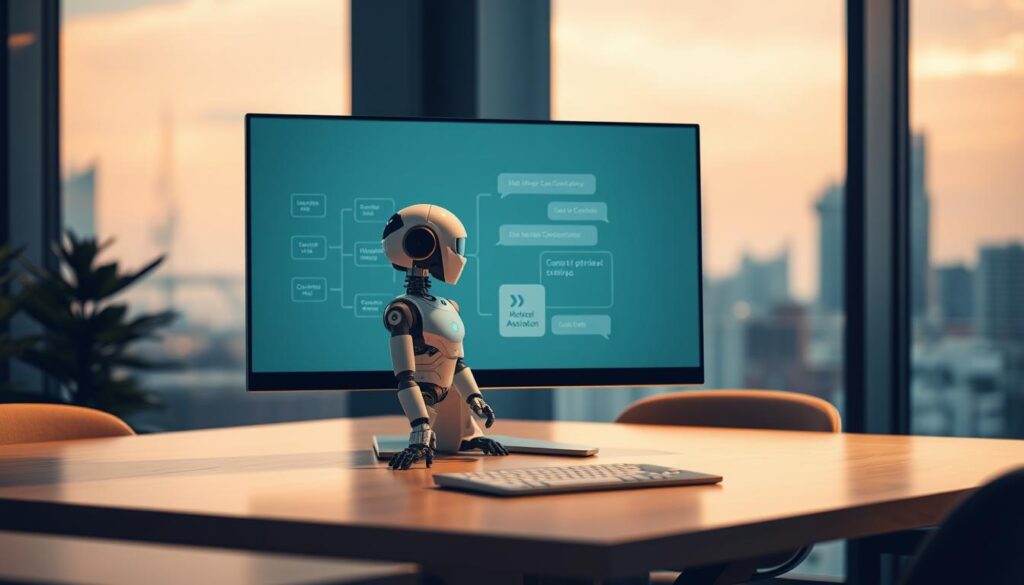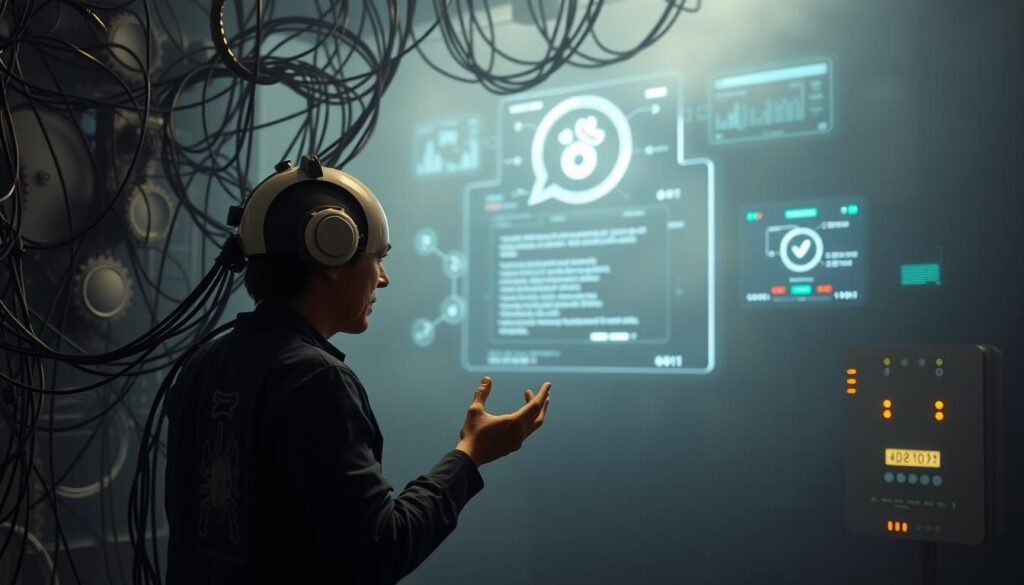Have you ever wondered how businesses manage to provide instant answers to customer questions, even outside working hours? The secret lies in the power of artificial intelligence and advanced software solutions. These tools are transforming the way companies interact with their audience, offering seamless and efficient support.
Modern systems designed for customer service are no longer limited to basic FAQ responses. They’ve evolved into sophisticated platforms capable of handling complex queries and mimicking human interaction. With 85% of executives expecting generative AI to dominate customer interactions within two years, it’s clear that this technology is here to stay.
These solutions are not just about answering questions. They integrate with platforms like Microsoft Teams and CRM systems, streamlining workflows across departments. From sales to HR, their applications are vast, ensuring businesses stay ahead in a competitive market.
Key Takeaways
- Advanced software automates customer interactions, reducing operational costs.
- Generative AI is expected to dominate customer service within two years.
- 24/7 availability sets these tools apart from human support teams.
- Integration with platforms like Microsoft Teams enhances functionality.
- Applications extend beyond customer service to HR and sales workflows.
What Are Chatbots?
In today’s digital age, instant communication is no longer a luxury but a necessity. Businesses are turning to advanced software solutions to meet this demand. These tools, often referred to as chatbots, are designed to simulate human conversation and provide quick, accurate responses to customer inquiries.
At their core, these digital interfaces use predefined rules or artificial intelligence to interact with users. Key components like natural language processing and machine learning algorithms enable them to understand and respond to queries effectively. Whether answering questions, automating tasks, or collecting lead information, their primary functions are diverse and impactful.
These tools are deployed across various channels, including websites, messaging apps like WhatsApp and Slack, and even voice interfaces. This versatility ensures businesses can meet customers where they are. With a 64% increase in demand for immediate responses, their role in modern customer support is undeniable.
Unlike live chat, which relies on human operators, these solutions are fully automated. This not only reduces costs but also ensures 24/7 availability. For example, Zenefits’ Website Concierge uses AI to handle complex user queries, showcasing their potential in enhancing customer experiences.
As expectations for personalized interactions grow—26% since 2020—these tools are becoming essential for businesses. From sales to internal workflows, their applications are vast, making them a cornerstone of modern customer engagement strategies.
The Evolution of Chatbots
The journey of conversational tools has been a fascinating evolution from simple scripts to intelligent systems. Over the decades, these tools have transformed how businesses and individuals interact with technology. What began as basic rule-based systems has now become a cornerstone of modern communication.
From Rule-Based to AI-Powered
In the 1960s, the first primitive chatbot, MIT’s Eliza, laid the foundation for this technology. These early systems relied on predefined rules and menu-driven interactions. Users had to input specific keywords to get responses, limiting their flexibility.
The breakthrough came with natural language processing (NLP). This advancement allowed conversational tools to understand free-form queries and respond contextually. The integration of machine learning further enhanced their ability to learn from interactions and improve over time.
The Rise of Generative AI
Today, the focus has shifted to generative AI. Tools like ChatGPT have revolutionized the field by creating human-like content and resolving complex issues autonomously. Enterprises are leveraging platforms like IBM watsonx Orchestrate to build business-specific agents tailored to their needs.
Security has also seen significant advancements. Features like Zendesk’s Advanced Customer Data Privacy ensure safe and secure interactions. Looking ahead, experts predict a fivefold increase in customer interactions within three years, driven by these intelligent systems.
- 1960s origins: MIT’s Eliza as the first primitive chatbot.
- Rule-based era: Menu-driven systems requiring specific keyword inputs.
- NLP breakthrough: Contextual understanding of free-form queries.
- Generative AI revolution: ChatGPT-style content creation capabilities.
- Current state: Autonomous AI agents resolving complex issues without human help.
How Do Chatbots Work?
Ever wondered how technology understands and responds to human queries instantly? The answer lies in two core technologies: natural language processing (NLP) and machine learning. Together, these systems enable automated tools to interpret user input, learn from interactions, and provide accurate answers.
Natural Language Processing (NLP)
NLP is the backbone of how these systems interpret human language. It breaks down open-ended input to understand intent, extract key entities, and analyze sentiment. For example, when a user asks, “What’s the status of my order?” NLP identifies the intent as a query about order status and retrieves the relevant data.
This technology also enables context retention, allowing the system to remember previous interactions. This ensures personalized responses, making customer interactions more meaningful.
Machine Learning and Continuous Improvement
Machine learning takes these systems a step further by enabling continuous improvement. By training on historical chat logs and user feedback, the system refines its responses over time. This creates a granular knowledge base that enhances accuracy and efficiency.
Integration with backend systems like CRM and ERP ensures seamless workflows. For instance, Drift’s conversational AI uses visitor intelligence to qualify leads, showcasing the depth of integration possible.
- NLP mechanics: Intent recognition, entity extraction, sentiment analysis.
- Machine learning loop: Training on historical chat logs and user feedback.
- Context retention: Remembering previous interactions for personalized responses.
- Integration depth: Connecting with CRM, ERP, and backend databases.
- Security protocols: Encryption of sensitive data during password resets.
- Multilingual support: Handling 100+ languages in enterprise solutions.
These technologies work together to ensure that automated systems can answer questions accurately and efficiently. As they evolve, their ability to mimic human conversation continues to improve, making them indispensable in modern business operations.
Types of Chatbots
Businesses today rely on various automated tools to enhance customer interactions and streamline operations. These tools come in different forms, each designed to meet specific needs. Understanding the types available can help organizations choose the right solution for their goals.
Rule-Based Chatbots
Rule-based systems operate on predefined decision trees. They follow a set of instructions to respond to user queries. While effective for simple tasks like answering FAQs, their flexibility is limited. They cannot handle complex or open-ended questions without human intervention.
For example, a rule-based chatbot might guide users through password resets or basic troubleshooting. These systems are cost-effective but lack the advanced capabilities of AI-driven solutions.
AI Chatbots
AI-powered tools leverage machine learning and natural language processing to understand user intent. They can handle free-form queries and improve over time by learning from interactions. This makes them ideal for complex tasks like sales pipeline management or resolving customer complaints.
Brands like PTC use AI chatbots to target specific personas, ensuring industry-specific queries are addressed accurately. These systems offer a more personalized customer experience compared to rule-based alternatives.
Live Chat Solutions
Live chat combines automation with human support. It allows users to interact with a bot initially, but complex issues are escalated to a human agent. This hybrid approach ensures efficiency while maintaining a personal touch.
For instance, Zendesk’s autonomous AI agents handle refunds and exchanges, reducing the workload on human teams. This balance between automation and human intervention makes live chat a versatile solution for businesses.
Benefits of Chatbots
Businesses are leveraging advanced tools to enhance customer experiences and drive growth. These solutions offer a range of advantages, from operational efficiency to improved engagement. Let’s explore the key benefits chatbots bring to the table.
24/7 Customer Support
One of the standout features is their ability to provide round-the-clock assistance. Unlike human teams, these tools are always available, ensuring customers get instant responses. This leads to higher satisfaction and a 64% reduction in churn rates.
For example, e-commerce platforms use them to recommend products during browsing sessions. This not only improves the shopping experience but also boosts sales.
Cost Efficiency
Automated solutions significantly reduce operational costs. By handling repetitive tasks, they free up human resources for more complex issues. Companies like Drift have reported a 670% ROI, showcasing their financial impact.
Additionally, they can handle unlimited queries simultaneously. This scalability ensures businesses can grow without increasing support costs.
Improved Lead Generation and Conversion
These tools excel at capturing and nurturing leads. By engaging visitors in real-time, they can increase lead-to-pipeline conversion rates by up to 100%. For instance, Lessonly’s conversational content has driven significant demo bookings.
Moreover, 72% of CX leaders emphasize the importance of brand-aligned personas. This ensures interactions feel personalized and aligned with company values.
- Operational savings: 24/7 coverage without staffing costs.
- Sales impact: Potential for 100% lead-to-pipeline conversion increase.
- Customer retention: 64% reduction in churn through instant support.
- Scalability: Simultaneous handling of unlimited user queries.
- Real results: Proven ROI and ARR growth in target accounts.
Challenges of Chatbots
While automated tools offer numerous advantages, they also come with their own set of challenges. From misinterpretation of user queries to concerns over data security, these issues can impact their effectiveness and reliability.
Misinterpretation and Miscommunication
One of the most common issues is the misinterpretation of user input. Slang, misspellings, or ambiguous phrasing can lead to errors, with studies showing a 20% error rate in some cases. This can frustrate users and reduce trust in the system.
Additionally, these tools often struggle with context retention. While they can handle straightforward queries, complex or multi-turn conversations may require human intervention. This highlights the need for hybrid solutions that combine automation with human oversight.
Security and Privacy Concerns
Data security is another significant challenge. Sensitive information entered into these systems can sometimes end up in public training datasets, leading to potential data leakage. This raises serious concerns, especially in industries handling confidential customer data.
Compliance with regulations like GDPR and CCPA adds another layer of complexity. Businesses must ensure that conversation logs are securely stored and managed to avoid legal repercussions. Implementing enterprise-grade confidentiality protocols, such as those offered by IBM, can help mitigate these risks.
- Language limitations: Slang and misspellings can cause up to 20% error rates.
- Data risks: Sensitive information may enter public training datasets.
- Compliance hurdles: GDPR and CCPA require secure conversation logging.
- Maintenance demands: Continuous optimization is essential for accuracy.
- Hybrid solutions: Combining automation with human oversight improves reliability.
Chatbot Use Cases
From answering customer queries to streamlining internal workflows, automated tools are reshaping industries. These use cases span across various sectors, offering solutions that enhance efficiency and improve user experiences. Whether it’s resolving FAQs or managing complex workflows, the applications are vast and impactful.
Customer Service
One of the most common applications is in customer service. Automated systems provide instant FAQ resolution across multiple channels, including websites and messaging apps. For example, retail businesses use these tools to update customers on order statuses, integrating with carriers for real-time tracking.
In healthcare, appointment scheduling has reduced no-shows by 18%, showcasing their ability to improve operational efficiency. These systems also handle multilingual support, ensuring accessibility for diverse customer bases.
Sales and Marketing
In the realm of sales, these tools are transforming lead generation and conversion. Platforms like Drift notify teams of high-value account activities in real-time, enabling timely follow-ups. This has led to significant increases in lead-to-pipeline conversion rates.
Additionally, they assist in promoting products and services by engaging visitors with personalized recommendations. This not only boosts sales but also enhances the overall customer experience.
Internal Business Processes
Beyond customer-facing roles, these tools streamline internal operations. HR departments use them for benefits enrollment and PTO requests, reducing administrative burdens. In manufacturing, they notify teams of supply chain disruptions, ensuring timely resolutions.
IT support teams benefit from automated password reset workflows, improving response times and reducing ticket backlogs. These internal use cases highlight the versatility of automated systems in driving organizational efficiency.
Best Practices for Implementing Chatbots
Implementing automated tools effectively requires a strategic approach to maximize their potential. By following proven best practices, businesses can ensure seamless integration and optimal performance. Let’s explore the key steps to success.
Choosing the Right Solution
Selecting the appropriate software is the first critical step. Businesses must decide between no-code platforms for simplicity or API-driven solutions for advanced customization. Evaluating AI transparency, backend integration, and omnichannel support ensures the tool aligns with organizational needs.
Integrating with Existing Systems
Seamless integration with CRM, ERP, and other backend systems is essential. This ensures the tool can access relevant data and streamline workflows. For example, connecting with sales pipelines can enhance lead management and improve efficiency.
Training and Continuous Improvement
Training the system using historical chat logs helps refine intent modeling and improve accuracy. Regular updates and quarterly optimization cycles ensure the software evolves with user needs. Additionally, staff training on agent-bot collaboration workflows enhances overall team productivity.
- Platform selection: No-code vs API-driven solutions.
- Integration depth: CRM/ERP connectivity requirements.
- Training protocols: Using historical chat logs for intent modeling.
- Brand alignment: Customizable personas and tone guidelines.
- Security audits: Regular penetration testing schedules.
- Analytics setup: Conversation success rate tracking.
- Maintenance plan: Quarterly optimization cycles.
- Staff training: Agent-bot collaboration workflows.
Conclusion
The future of customer engagement is being reshaped by intelligent systems. Adopting artificial intelligence-driven tools is no longer optional but a strategic imperative for businesses aiming to stay competitive. A phased implementation roadmap ensures smooth integration, while enterprise-grade solutions like IBM watsonx offer robust capabilities for scaling operations.
Looking ahead, autonomous AI agents are projected to handle 80% of customer interactions, significantly enhancing efficiency. To achieve success, businesses should target a 40% reduction in operational costs while balancing automation with human oversight. This approach ensures a seamless customer experience without losing the personal touch.
For deeper insights, download Gartner’s agentic AI research report. With the chatbot market expected to reach $4.9 billion by 2027, now is the time to invest in these transformative technologies. Embrace the future of support and service to drive growth and innovation.







